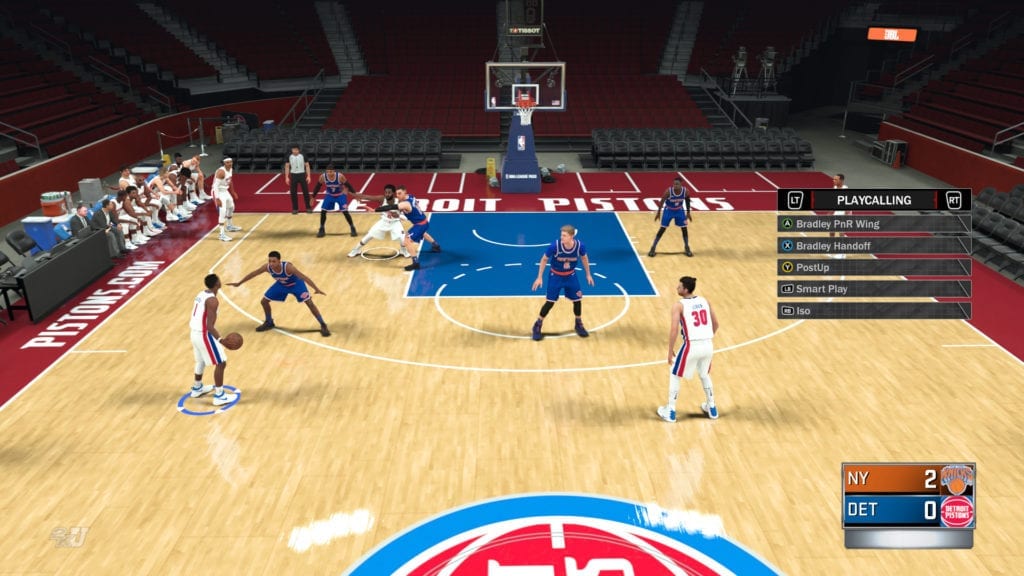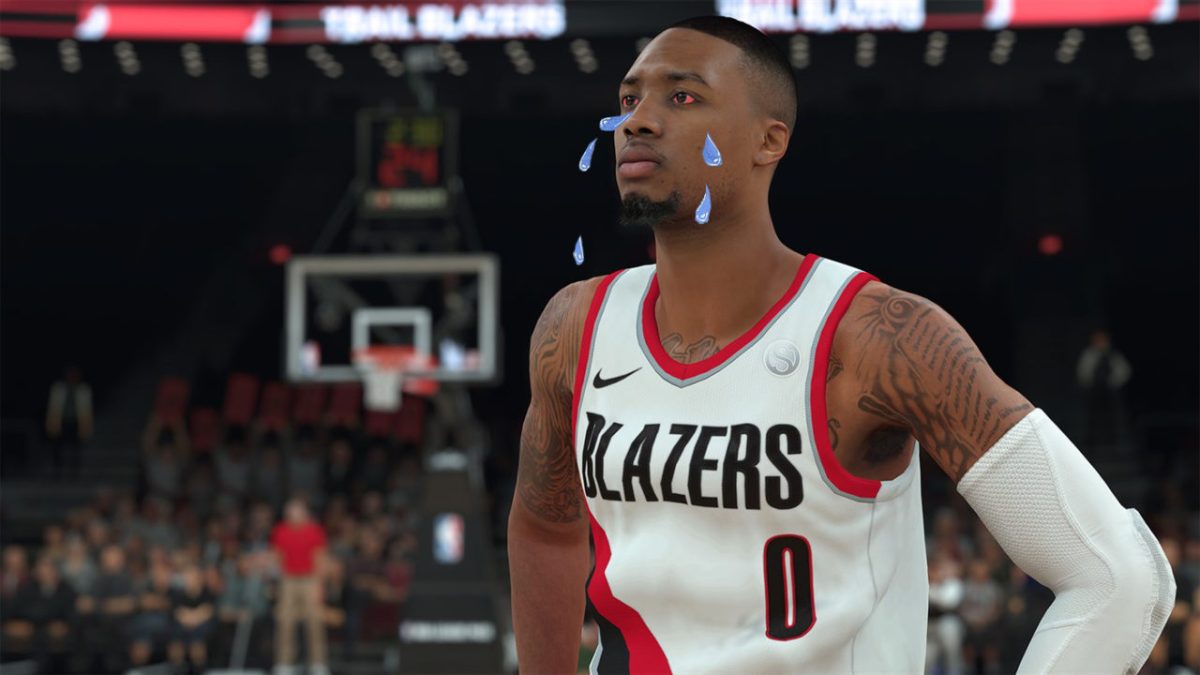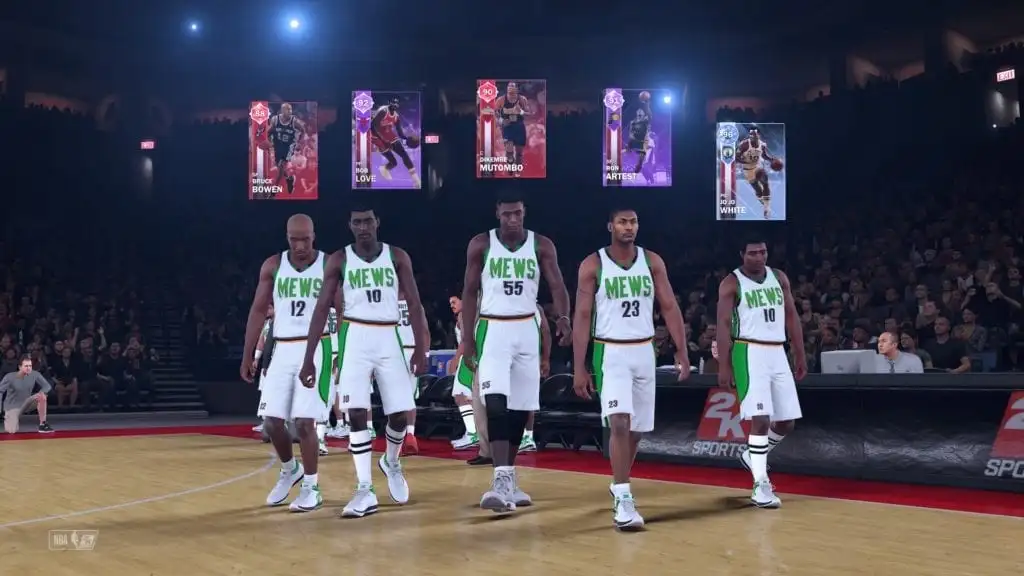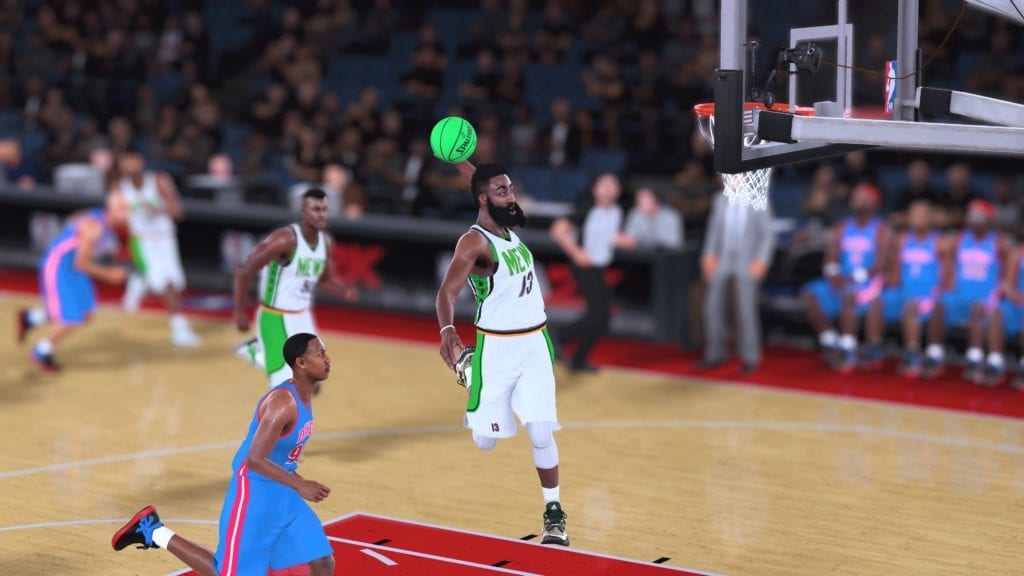What’s happening 2K Hoop fans? I am Nino Samuel aka Da_Czar and I am an AI producer for NBA 2K18. I am so excited to be able to share a little of what we have in store for you on the offensive AI side of NBA 2K18.
I have the benefit of working with an incredibly talented and dedicated group of producers and engineers. At this point in the year we have put so much into the game that it is honestly difficult to narrow down the best way to relate the impact of our changes to your game-play experience.
I will take you through the 3 key areas of improvement: Tendencies, AI execution and Motion. First, here are a few general improvements I want mention before we jump into the deep end.
Play Calling & Subs
We have moved the selection of plays and substitutions from the right stick back to the buttons. To bring up the dynamic play menu you now press the d-pad to the left. And make your selection by pressing the corresponding button.
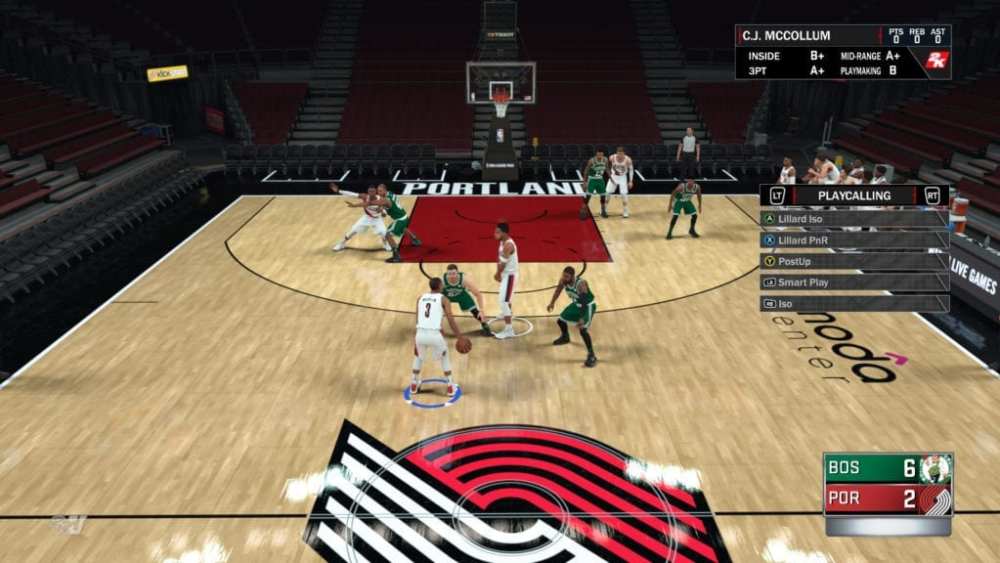
From the dynamic play menu use you can toggle over to freelance style and freelance sets with LT/RT.
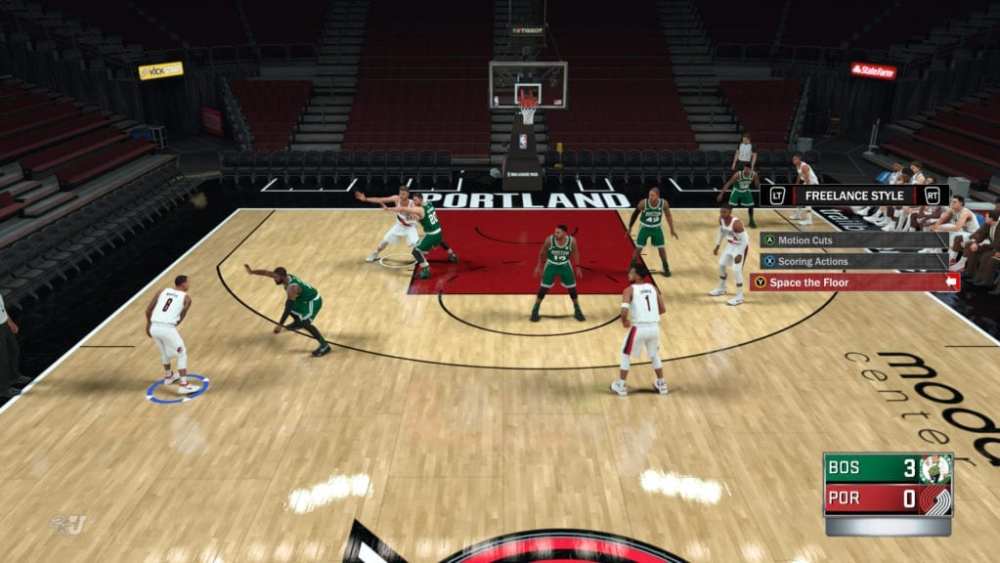
Your current selection will he highlighted in red
Tapping RT again will take you from freelance style to freelance set selection. This year we added the ability to display the name of the default freelance for the selected team.
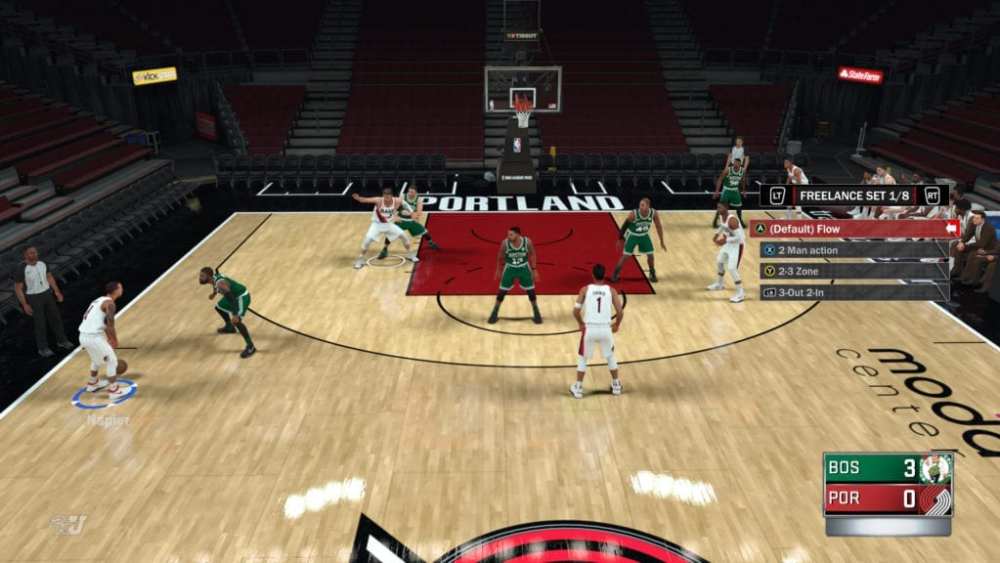
To select game-plan items like rebounds, tempo, focus and play through press d-pad right and toggle using LT/RT.
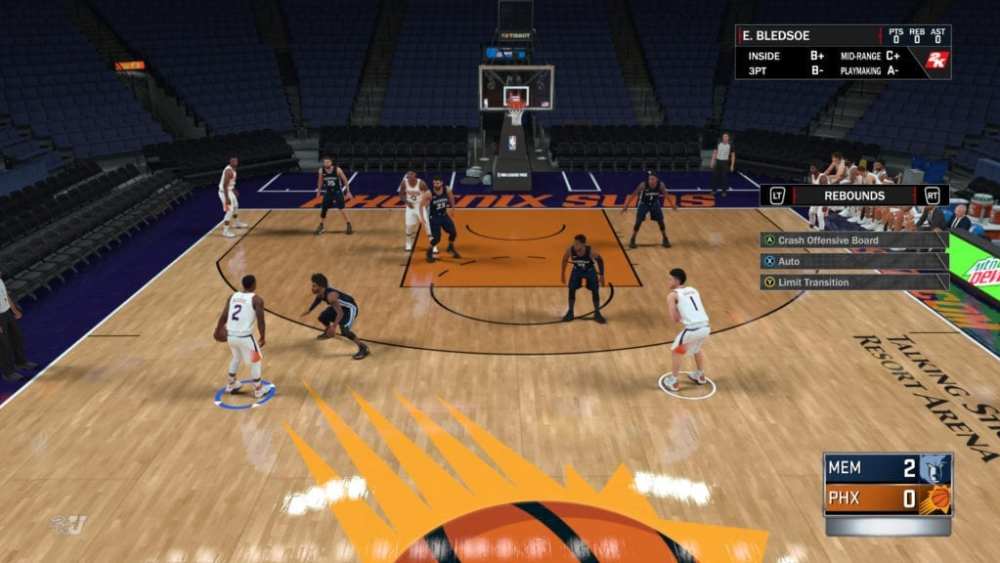
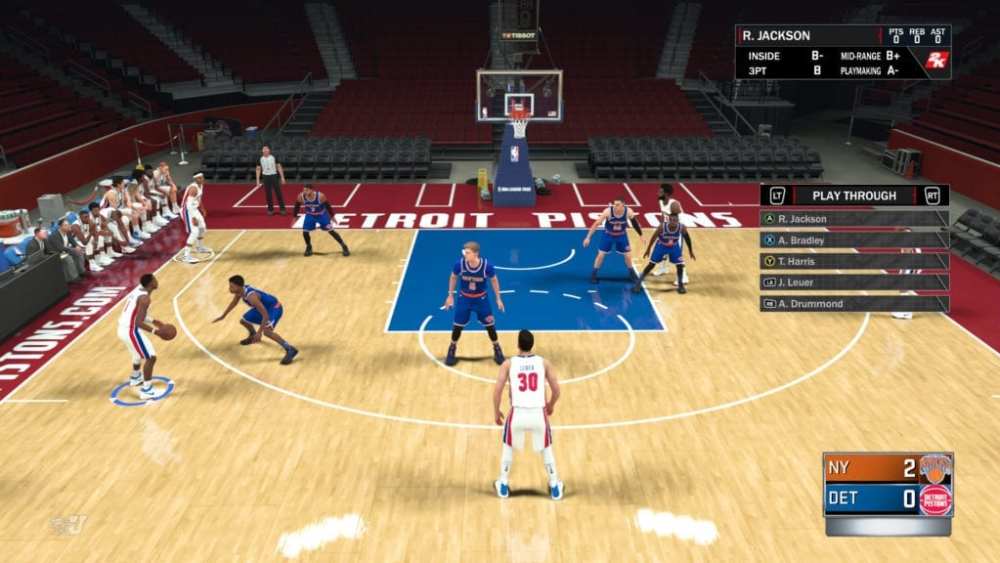
You can call a smart play using the dynamic play menu we showed you earlier by pressing d=pad left and then pressing LB. Or you can simply press d-pad up to access a smart play.
To call player specific plays you tap the LB/L1 button then select the icon over the player you want to call a play for. The first page will display player specific quick plays.
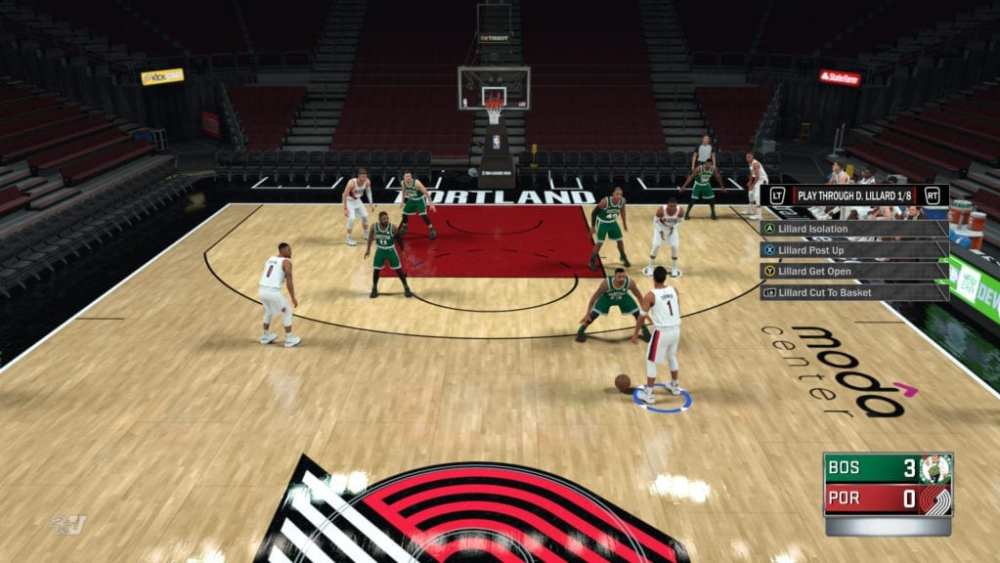
Toggle LT/RT to access plays for the player selected from the team’s playbook. Select the play you want by pressing A, X, Y, or LB.

Press d-pad down to bring up the substitution menu press the button of the player you would like to sub out of the game.
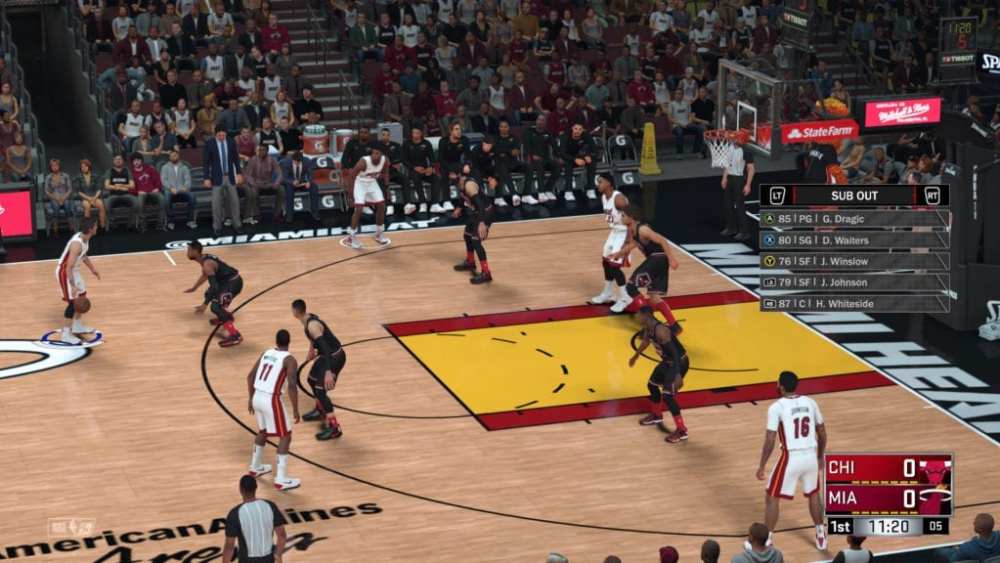
Then select the icon of the player you want to sub in.
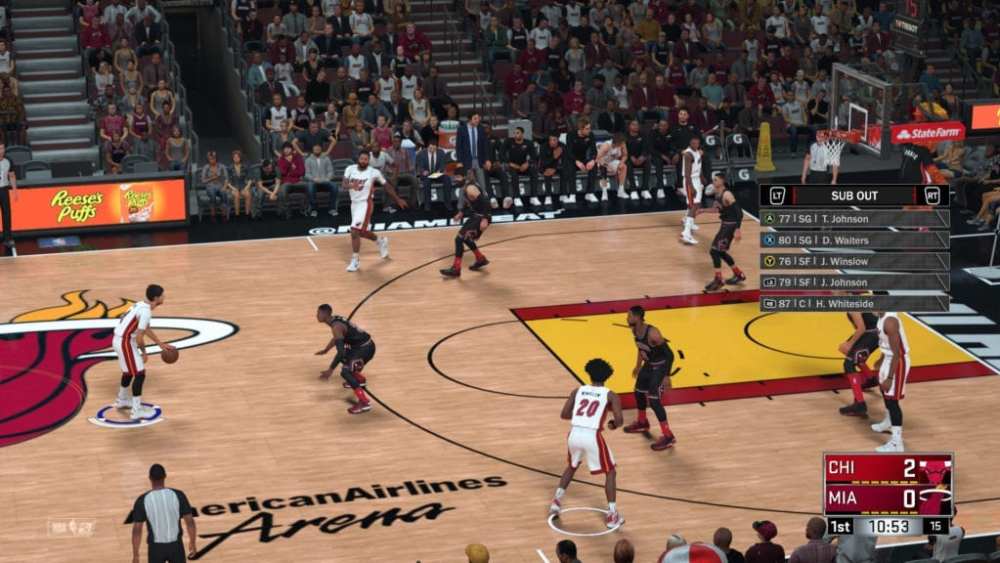
TENDENCIES
Almost nothing can enhance a game-play experience vs the AI like clearly defined tendencies. Last year you may recall we deployed a massive tendency updates to signal a new found commitment towards giving the tendencies their proper place in the spot-light.
Traditionally, video game tendencies can sometimes suffer from what I call tendency overlap. This occurs when you have one front-end tendency that may be controlling more than one outcome or situation.
One such tendency in NBA 2K17 would be the shot three tendency. A high value here would make the player more likely to shoot threes. However, just because a player has a high 3 point tendency doesn’t mean that I want them to shoot three’s in every situation. It became clear that these tendencies needed more context.
So with that mindset we took our first step towards situational tendencies.
Spot-ups
Instead of a single three point shot tendency, this year we have situationally specific tendencies. One of the first situations I wanted to cover was spot-ups. This year when a player catches a pass in a spot-up situation we check the following tendencies to determine what this player is likely to do.
– Spot-up
o Shot Midrange
o Shot three
o Drive
When a player catches the ball in a spot-up situation in NBA 2K18 we first look to determine if the pass was caught in mid-range or three-point territory. Then we compare the shot and drive tendency to determine if this player is likely to drive or shoot in this situation.
The same calculation is made when the ball is caught in a spot-up behind the three point line.
Off-screen
Next we looked at Off-screen situations. Similar to spot-ups we make a determination on what range the player is at when he receives the ball after running off a screen. If it is mid-range we compare the shot mid-range with the off-screen drive tendency to determine the most appropriate course of action. Same logic follows if the catch was made behind the three point line.
– Off-screen
o Shot midrange
o Shot three
o Drive
Transition
We already account for general shot three tendencies as well as the AI’s desire to shoot from three in a spot-up and off-screen situation. So it only made sense to also account for players that like to pull-up for three in transition.
– Transition
o Pull-up Three
This tendency measures how likely a player is to pull up for three off the dribble in transition.
Step-backs driving pull-up
To deliver even more control into our users hands we broke out our step-back tendencies to allow for even greater player differentiation. We can create AI opponents who only step-back from mid-range, the three point line, or both.
– Step-back
o Midrange
o Shot three
We also reduced a value in code that had the AI attempting to reduce long 2 point shots by stepping back to shoot a three. This caused users to become frustrated with the AI stepping back when wide open, and then being too well defended to get a shot off in time.
Contested shots
Additionally, we broke out our contested shots in the same manner so you can feel the difference between the mid-range contested shots that Carmelo might take vs Chef Curry cooking up defenders from deep.
– Contested
o Shot midrange
o Shot three
Driving pull-up
If in a spot-up, off-screen or isolation opportunity and the appropriate Drive tendency determines that a drive should occur, we’ve included pull-up tendencies for both mid, and three point range.
– Driving
o Pull-up mid-range
o Pull-up three
Isolation
While scouting the league this past year I noticed something I wanted to replicate in our game. When elite scorers have a matchup with an inferior defender they tend to be more aggressive offensively.
So this year we introduced new isolation tendencies that measure the AI players aggressiveness in relation to the quality of the defender.
This is essentially code that allows the AI to stare at your digital bench and yell to your coach, “They are going to need some help tonight. They can NOT guard me!”
At any step of our choosing during a play or freelance action, we can run a check for the current ball-handlers tendency to isolate. This value is determined by comparing the offensive players scoring ability against the defenders ability to guard him.
Each player falls into one of four categories as an on-ball defender. Defenders are rated as poor, average, good or elite.
– Isolation
o Iso vs poor
o Iso vs average
o Iso vs good
o Iso vs elite
This is a subtle layer of sophistication that enables scorers to be more aggressive and increase their touches even for plays that were not initially ran for them.
Don’t be surprised to see the top scorers in the league wave off a play because they like their chances of scoring against their current match-up.
We also use this to run a check for non-isolation players, who may have a decided post-up advantage, and allow them to break a play to go beast mode on their matchup.
AI Execution
Although we have added incredible tools these past three years for the users, our AI has lacked an ability to execute at an equally high level. This year we made a number of improvements that on their own don’t sound all that impressive. However, when you take them all as a package this is easily our finest effort yet in giving the AI the ability to execute. We touched and improved on many systems but this is a listing of a few of the major system improvements you can expect to see.
Transition
Last year was phase one of the upgrade of our transition engine. In year one we established a foundation that we were able to build upon this year to bring you our finest effort yet.
Last year in certain situations the system struggled with choosing the correct player to fill the lanes vs cut to the basket. So this year in addition to multiplying our coverage, we also added a new tendency to help control this behavior.
Transition spot-up vs Cut.
Once in a fast-break situation our transition operates in three phases, all of them editable and updateable through an ACE roster update.
At each phase the system is looking for offense vs defense numbers advantages. The advantage or disadvantage may change as the ball is advanced up the floor.
Once the finishing stage is reached, many of our finishing transition sets have branch-able options that check the transition spot-up vs cut tendency to determine if a player should stop at the three or cut to the basket.
In some formations we don’t check for the tendency. We choose whether a player cuts to the rim or stops at the three based on spacing. One example is a 3 v 1 tight transition formation where the two perimeter wings are very close to the ball in the middle of the floor. In this instance both perimeter players go to the rim and then continue out to the corners.
Another addition for transition this year is that once we identify the trailer, we slow him down to increase spacing and allow for opportunities to walk into open three’s when opponents are clogging the paint.
Motion
Our AI’s ability to run an offense is greatly enhanced by the new motion system. The system can stitch together any applicable movement in our extensive library of motion capture to allow us to have basketball specific movement while maintaining the flexibility to be able to, at any point in the route, change direction based on stick input.
The offensive flow in NBA 2K18 would not be possible without the benefits offered by this new motion system. We can now run more complex actions in less time. In previous games there were many small tweaks we had to make in order to complete more complex actions. Each of these tweaks added minute delays that when added all together, would increase the time it took for plays and actions to complete. With all of those tweaks removed our game has a dynamic flow and pace that it has never had before.
Tempo
Another area we really worked on improving our AI execution is the tempo that teams play at. In NBA 2K18 you will see a definite difference between top and bottom ranked teams in their pace of play.
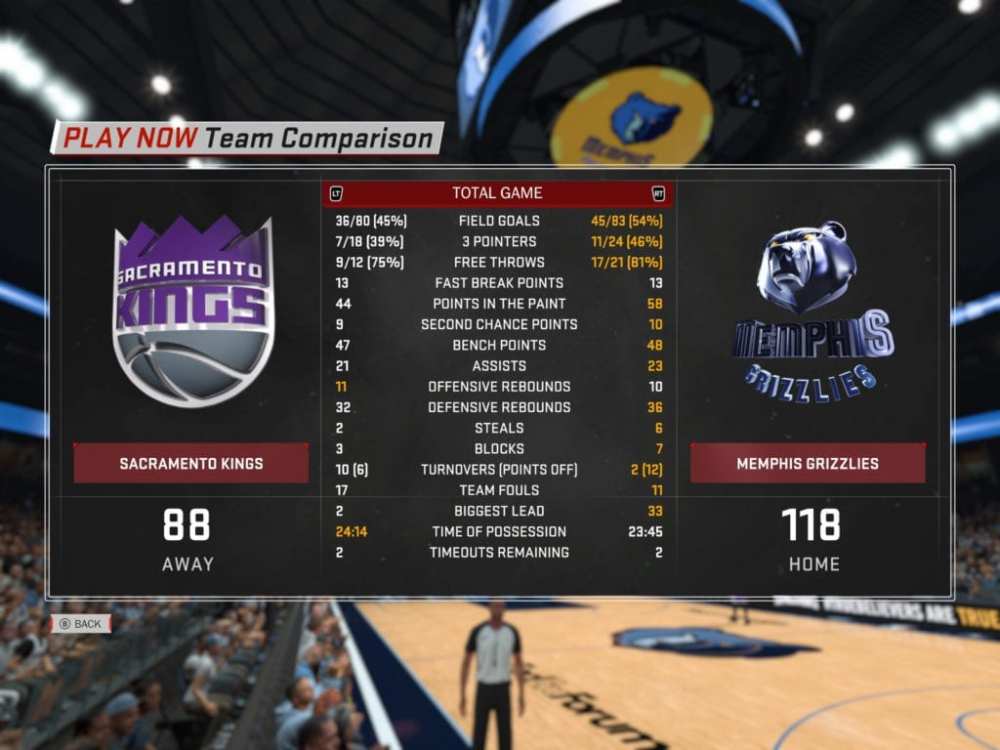
In AI vs AI 12 min quarter games I have seen the AI score as few as 80 and as many as 136 point in a single game.
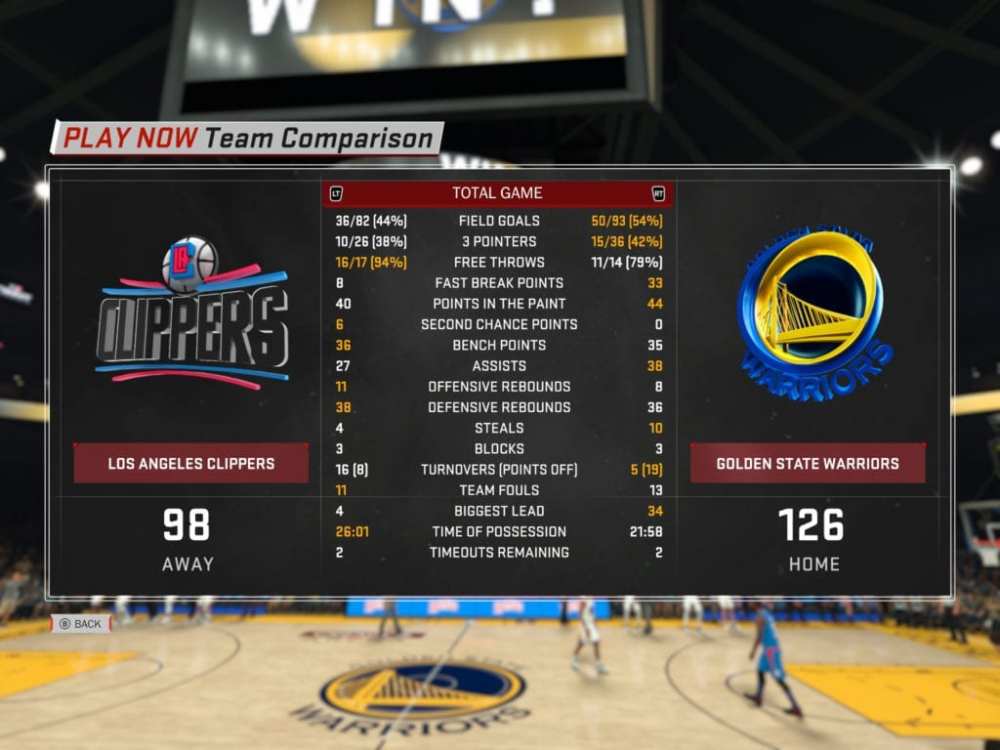
The difference between Phoenix and the Jazz has never been this noticeable in our game. Slower paced teams will walk the ball up the floor and look to score later in the shot clock.
While teams who prefer to play at a higher tempo will advance the ball quickly, and on misses, look to score out of their early offense sets.
Flow Tech
If you are a person who loves the X’s and O’s of basketball like I do, then Flow Tech will easily be the most exciting information in this blog. My main AI Engineer and I have had a vision we’ve been trying to replicate since I first arrived at 2K. Each year we continued to add the technical pieces that were necessary to one day get us to this point.
Flow Tech is a series of technical improvements to our play and freelance systems that give NBA2K18 unparalleled AI execution potential on the offensive side of the ball. Flow tech allows us to implement intelligence at the point of resistance in very specific areas of our game.
The best way to explain Flow Tech is by showing you. Let’s begin with an action in NBA 2K17 called Floppy Fist.
This is a high ball screen followed by a double high off-ball screen; this has been one of my favorite NBA actions for some time now. With limited exceptions, once a user knows the route of this play it is easy to shut down.
As a user defender vs the AI, after I have seen this play a few times I am free to totally disrupt his route with few discernable consequences.
We did provide a stationary defender location read branch once the offensive player was under the basket.
Even if the pass is not stolen, there is limited opportunity for a shot using this action once a user is aware of the branch options.
Now let’s look at a similar play in NBA 2K18 with the same action as floppy fist in NBA2K17, except this play does not start with a ball screen.
To get this example of the play to show to you in its original form I had to turn Flow Tech off. As you can see Redick runs off the double high screen, stops outside the block and then runs off the double screen for an open three.
Remember this is Redick’s designed stopping location.
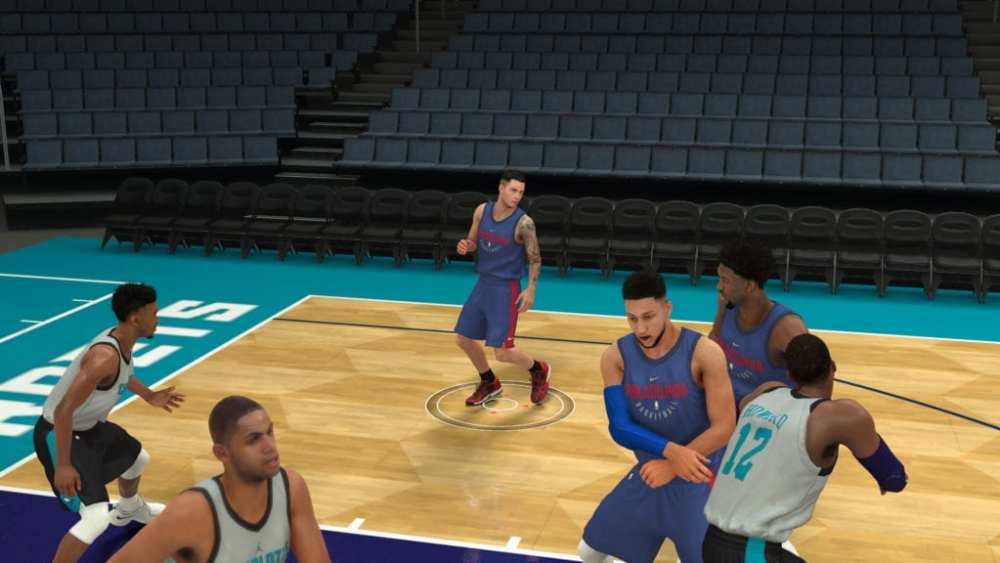
Now let’s re-enable Flow Tech and try to disrupt the play las a user defender like we were able to do in NBA 2K17.
Here you see Redick takes an alternate route and forces a defensive switch, then reads the switched defenders location at the basket branch point and continues off the opposite down screen. Now that I see I can’t overplay, let’s see if I can just meet him under the basket.
As I attempt to meet him at the rim Redick fades the screen (his screeners adjust their screen for the flare). Since we can’t deny him and we also can’t cheat the screen now, we are forced to trail him and fight through the screens.
This time he fakes the curl gets me out of position and goes backdoor. Let’s try that again.
If you noticed, because Redick knows we trailed him he passed the original stopping location which was outside the paint and went directly to the branch read under the basket. Then continued off the opposite down screen.
Now let me see if I can bait him into taking that opposite screen and jump the passing lane.
Finally, as a user defender it takes more than just knowing the play. Now, like in the NBA you still have to guard the actions.
Flow tech is only enabled for current teams. Some actions offer tons of counters and some don’t offer any. It all depends on the action and speed of the play. Each play in 2K18 has custom Flow counters designed to make it more difficult for users to deny the AI entry passes.
If you know me I could drone on and on about this all day long but I have already kept you too long. As per usual I will be breaking down the ins and outs of my favorite sets all season long. So, here’s one final read that the AI can make out of this set.
That’s right family. It’s REAL NOICE! So this time he reads curl to curl to curl. We didn’t even go over every AI read for each action for this one play!
Hopefully I have been able to show why we believe NBA 2K18 is our best effort to date as far as offensive AI is concerned.
In closing,
I would like to remind you to not forget about our Isolation vs defender quality tendencies. Otherwise, while you are working hard to prevent an open perimeter shot, the AI ball-handler might feel like your team-mate just can’t guard him!
Until next time, it’s your man Da_Czar wishing you a merry 2K Holiday!
#SimNation bonus footage


